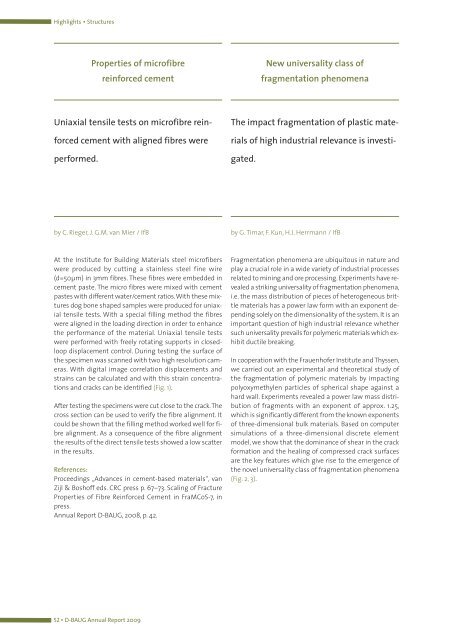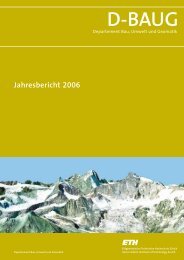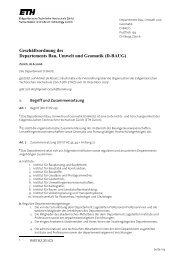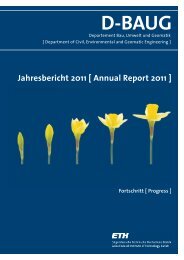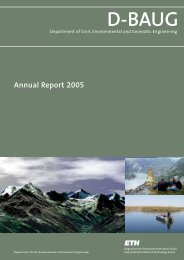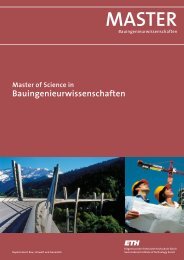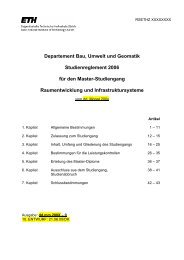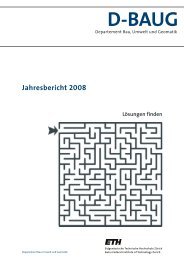D-BAUG - Departement Bau, Umwelt und Geomatik - ETH Zürich
D-BAUG - Departement Bau, Umwelt und Geomatik - ETH Zürich
D-BAUG - Departement Bau, Umwelt und Geomatik - ETH Zürich
You also want an ePaper? Increase the reach of your titles
YUMPU automatically turns print PDFs into web optimized ePapers that Google loves.
Highlights ▪ Structures<br />
Properties of microfibre<br />
reinforced cement<br />
Uniaxial tensile tests on microfibre rein-<br />
forced cement with aligned fibres were<br />
performed.<br />
At the Institute for Building Materials steel microfibers<br />
were produced by cutting a stainless steel fine wire<br />
(d=50µm) in 3mm fibres. These fibres were embedded in<br />
cement paste. The micro fibres were mixed with cement<br />
pastes with different water/cement ratios.With these mixtures<br />
dog bone shaped samples were produced for uniaxial<br />
tensile tests. With a special filling method the fibres<br />
were aligned in the loading direction in order to enhance<br />
the performance of the material. Uniaxial tensile tests<br />
were performed with freely rotating supports in closedloop<br />
displacement control. During testing the surface of<br />
the specimen was scanned with two high resolution cameras.<br />
With digital image correlation displacements and<br />
strains can be calculated and with this strain concentrations<br />
and cracks can be identified (Fig. 1).<br />
After testing the specimens were cut close to the crack.The<br />
cross section can be used to verify the fibre alignment. It<br />
could be shown that the filling method worked well for fibre<br />
alignment. As a consequence of the fibre alignment<br />
the results of the direct tensile tests showed a low scatter<br />
in the results.<br />
References:<br />
Proceedings „Advances in cement-based materials“, van<br />
Zijl & Boshoff eds. CRC press p. 67–73. Scaling of Fracture<br />
Properties of Fibre Reinforced Cement in FraMCoS-7, in<br />
press.<br />
Annual Report D-<strong>BAUG</strong>, 2008, p. 42.<br />
52 ▪ D-<strong>BAUG</strong> Annual Report 2009<br />
The impact fragmentation of plastic mate-<br />
rials of high industrial relevance is investi-<br />
gated.<br />
New universality class of<br />
fragmentation phenomena<br />
by C. Rieger, J. G.M. van Mier / IfB by G. Timar, F. Kun, H.J. Herrmann / IfB<br />
Fragmentation phenomena are ubiquitous in nature and<br />
play a crucial role in a wide variety of industrial processes<br />
related to mining and ore processing. Experiments have revealed<br />
a striking universality of fragmentation phenomena,<br />
i.e. the mass distribution of pieces of heterogeneous brittle<br />
materials has a power law form with an exponent depending<br />
solely on the dimensionality of the system. It is an<br />
important question of high industrial relevance whether<br />
such universality prevails for polymeric materials which exhibit<br />
ductile breaking.<br />
In cooperation with the Frauenhofer Institute and Thyssen,<br />
we carried out an experimental and theoretical study of<br />
the fragmentation of polymeric materials by impacting<br />
polyoxymethylen particles of spherical shape against a<br />
hard wall. Experiments revealed a power law mass distribution<br />
of fragments with an exponent of approx. 1.25,<br />
which is significantly different from the known exponents<br />
of three-dimensional bulk materials. Based on computer<br />
simulations of a three-dimensional discrete element<br />
model, we show that the dominance of shear in the crack<br />
formation and the healing of compressed crack surfaces<br />
are the key features which give rise to the emergence of<br />
the novel universality class of fragmentation phenomena<br />
(Fig. 2, 3).


